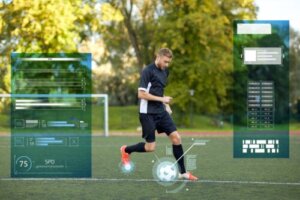How is Artificial Intelligence Used in Professional Soccer?

Technology has been in sports for a long time, and every day we find new developments that catch our attention. One of them is artificial intelligence or AI, a tool that’s increasingly used and has become almost indispensable in the elite world of professional soccer.
First of all, however, it’s a good idea to define the concept. AI is demonstrated by machines and generated by processors and software. One of its functions in sports is to analyze a huge amount of data, identify trends, and make predictions based on them.
In simpler words, artificial intelligence is exercised by machines that do the same as people, but on a large scale and with more precision and speed. Instead of having several people watching a game, the machines automatically record what happens and process the data.
For example, some companies that provide this type of service install cameras in stadiums to keep their own records of a game. By using these images, they’re able to extract millions of data using algorithms. This information is sold to athletes and clubs, who can then get a broader picture of what’s happening.
Like this article? You may also like to read: Kylian Mbappé: The Rigorous Exercise and Diet Routine of Soccer’s Next Big Star
Big data and the application of artificial intelligence
Big data is the name given to the large set of data that emerges from sports matches through the use of artificial intelligence. Currently, the teams that use this analytical method – that is, almost all the top international teams – have data on passes, distances, shots, and tackles, among others.
This has two major uses at first glance. The first is that it makes it possible to analyze the performance of the athletes on the team itself. This makes it possible to modify their training sessions and give greater relevance to one aspect over others.
Big data also offers the possibility of learning a great deal more about the players of other teams. This is positive both when facing them and during the transfer market, when it’s necessary to find “that one special player” who misses very few passes and has a certain type of performance in each match.

The goal is to reduce the random factor to a minimum when making decisions.
Artificial intelligence and new statistics
In addition to providing more data, artificial intelligence in soccer allows for better analysis. A demonstration of this is the creation of new terms to define variables that have recently begun to be measured, such as expected goals (xG) and expected assists (xA).
According to the official website of the Bundesliga, Germany’s professional soccer league, expected goals show the probability of a player scoring a goal using an index ranging from 0 to 1. This takes into account variables such as shooting position, distance to the goal, the goalkeeper’s position, the intervention of other defenders, and the player’s goal-scoring record, among other things.
A goal chance with a 0.5 xG register should result in a conversion 50% of the time.
On the other hand, expected assists are the passes in danger zones that can end in a goal by the player who receives them. This last pass prior to the goal is called an “assist.” Like expected goals, these are measured on a scale from 0 to 1, where the maximum value (1) represents a maximum probability that the play will end in a goal.
To illustrate this more clearly, if a player passes to a teammate who has his or her back to goal and is marked by opponents, the xA will be low. On the other hand, if he or she assists a teammate who is facing the goal and without a goalkeeper, the xA will be higher, since it’s very likely that this pass will end up being an assist.
We think you may be interested in reading this, too: Trent Alexander-Arnold: The Vision at the Heart of His Training Sessions
Artificial intelligence provides unprecedented data
Artificial intelligence has revolutionized soccer and other sports in recent years. Thanks to this tool, what used to depend on the perspective of the coach and his team is now perfectly evaluated and measured.
Some of these innovative measurements include not only physical efficiency, but also the cognitive performance of an athlete. For example, artificial intelligence makes it possible to measure the correctness of decision-making and the stress a player is under during a match.
Indexes have even been developed that gather all the available information, compare it with that of another team and thus establish the winning possibility for a team. This index is called ETI (technical efficiency index) and is based on mathematics to analyze the overall performance of a team from a collective tactical point of view.

A fundamental tool in modern soccer
Like any innovative element, artificial intelligence is still developing and new use cases are still being studied for the almost infinite possibilities it offers. Meanwhile, the technical staff of the teams are becoming increasingly friendly with these new technologies.
Ideally, there should be a group of specialists who digest all the information and hand over the most important to the coaches. After all, there’s no point in having so much data if there’s no one to interpret it.
In the meantime, since this is a compliment and not something that will win championships by itself, there are some things that are still essential. Work, planning, and talent must go hand-in-hand with technology to achieve the proposed objectives.
All cited sources were thoroughly reviewed by our team to ensure their quality, reliability, currency, and validity. The bibliography of this article was considered reliable and of academic or scientific accuracy.
- Conde, M. ¿Cómo funciona la inteligencia artificial utilizada por el Boca de Alfaro y la selección Ecuador? Big Data Sports. https://bigdatasports.media/2021/12/27/como-funciona-la-inteligencia-artificial-que-utilizada-por-el-boca-de-alfaro-y-la-seleccion-ecuador/
- Qué es el modelo xG: cómo funciona el sistema de “goles esperados” de Sportec Solutions. Bundesliga. https://www.bundesliga.com/es/bundesliga/noticias/goles-esperados-xg-sistema-que-es-como-funciona-sportec-solutions-liga-alemana-5580
- Whitmore, J. ¿Qué son las Expected Assists (xA)? The Analyst. https://theanalyst.com/eu/2021/07/que-son-las-expected-assists-xa/#:~:text=El%20modelo%20de%20Expected%20Assists%20(xA)%20de%20Stats%20Perform%20mide,realiza%20o%20no%20un%20disparo.
This text is provided for informational purposes only and does not replace consultation with a professional. If in doubt, consult your specialist.








